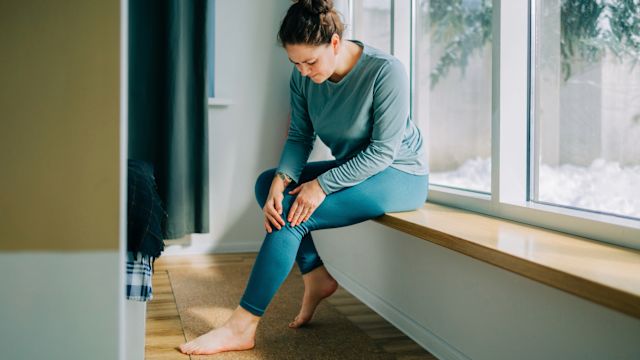Updated on December 12, 2025.
Whether your knees pop or you have stiffness and pain in your hands, you may wonder what your joint symptoms could mean for your health. Issues with joints often stem from injury, infection, or biomechanical issues, meaning how you're built and the way you move. But they can also point to degenerative joint conditions like osteoarthritis, which affects nearly 33 million adults in the United States.
Common joint symptoms
Here are some issues you may experience with your joints, what health conditions they could indicate, and when to see a healthcare provider (HCP).
Popping joints
Hearing a popping noise while bending or stretching is common and often harmless. It happens when tiny nitrogen gas bubbles form between joints, like your knees or shoulders, and get released during movement. It can also occur when ligaments glide over a joint and snap.
"It's not a sign of disease or injury unless the noise is accompanied by significant pain, warmth, or swelling," says New York-based rheumatologist Natalie Azar, MD. If your joints pop, watch for those other warning signs.
Crunchy joints
A crunching sound, especially in the knees, can be an early sign of osteoarthritis. "Cartilage is normally the shock absorber between bones, but it wears down in osteoarthritis, so bones rub together. That's what you're hearing," says Azar.
The crunch, called "crepitus" (Latin for "cracking"), is more of a sensation than a noise. If you put your hand over your knee while bending it, you can often feel a grating. Carrying extra weight can be a risk factor. If you're 30 or 40 pounds overweight, Azar recommends seeing an HCP about the possibility of osteoarthritis.
Swelling
"Swelling is always an issue—often a sign of injury, overuse, or arthritis," says Rick Olderman, a physical therapist in Denver. "You'll notice swelling mostly in areas where there's less muscle tissue, or in bony areas, such as knees, ankles, and wrists," he adds.
Injuries to joints, tendons, or ligaments are common causes of swelling, but it could also point to a chronic health condition like rheumatoid arthritis or gout. The presence of pain and redness could indicate an infection in the joint or tissue, as well.
Morning stiffness
"It's normal to wake up feeling stiff, especially in your 40s and 50s. But how long it lasts tells you if there's a problem," says Azar.
Some breakdown of the joints occurs naturally over time. That’s why mild osteoarthritis symptoms, like stiffness that lasts about 30 minutes, are common in middle age. But if stiffness lasts an hour or more, see an HCP. It could point to advanced osteoarthritis or an inflammatory condition, such as rheumatoid arthritis, lupus, or psoriatic arthritis, says Azar.
Discoloration
A change in skin color around the joints can be a sign of inflammation, which means your body may be responding to an injury or infection. Inflammation occurs when blood flows to the area to aid in healing. In lighter-skinned people, the color change is often red or pink. People with darker skin may see shades of purple or brown.
A change in skin color can be a symptom of polyarthritis, which is any type of arthritis that occurs in five or more joints.
Pain that won’t go away
Chronic joint pain is your brain signaling trouble somewhere in your body. The location usually offers a clue. For example, gout often occurs in the big toe.
Pain patterns in your joints can be revealing, as well, says Azar. Pain that moves from one joint to another could be acute rheumatic fever. Pain that strikes both sides of the body, like both hands, tends to happen with rheumatoid arthritis, while pain that's one-sided could be psoriatic arthritis. In osteoarthritis, it’s common for joints to feel painful during or after movement, or at the end of the day.
Strategies to protect your joints
Speak to an HCP about any joint symptoms that concern you. Be sure to reach out if these symptoms are new, long-lasting, severe, worsening, or accompanied by other symptoms.
Meanwhile, it's important to understand that your joints will experience wear and tear as you age. But there are ways to lower your risk of injury, osteoarthritis, and other joint issues as you grow older, says Azar. Start by taking steps to help keep joints healthy:
- Get plenty of physical activity.
- Wear the right protective gear for exercise and sports.
- Practice good posture and form as much as possible.
- Avoid or quit smoking.
- Eat a healthy diet.
- Maintain a healthy weight for your body.
Being overweight is a leading risk factor for several joint issues including osteoarthritis, because it puts stress on weight-bearing joints. Dropping extra pounds can often reduce the risk of developing these conditions or improve your symptoms if you’ve already been diagnosed.







